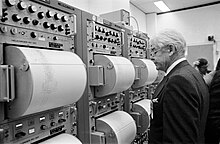



Lunar seismology is the study of ground motions of the Moon and the events, typically impacts or moonquakes, that excite them.
Several seismographic measuring systems have already been installed on the Moon and their data made available to scientists (such as those from the Apollo Lunar Surface Experiments Package). The existence of moonquakes was an unexpected discovery from seismometers placed on the Moon by Apollo astronauts from 1969 through 1972. The Apollo 11 instrument functioned through August of the landing year. The instruments placed by the Apollo 12, 14, 15, and 16 missions were functional until they were switched off in 1977.[1][2] Moonquakes are not believed to be caused by tectonic plate movement (as earthquakes are), but by tidal forces between Earth and the Moon.[3] Further data is needed to clarify the origins and effects of the forces causing moonquakes.
The Chandrayaan-3 mission by Indian Space Research Organisation had a payload ILSA (Instrument for Lunar Seismic Activity), to acquire data about moonquakes. It detected a presumed natural event on 26 August.[4] It is suspected to be a moonquake.[citation needed]
Several categories of moonquakes were recorded. Hundreds of deep moonquakes were recorded along with 28 shallow events. The deeper quakes are caused by tidal forces with the Earth and tended to occur in clusters.[5][6] The shallow events have tectonic origins. Although more rare than deep events, the shallow events were larger, with body wave magnitudes > 5.5 and stress drops exceeding 100 MPa.[7] Other sources of seismic activity included meteorite impacts and artificial signals from lunar modules.
One key finding was an improved understanding of the structure of the deep lunar interior, including the existence of a solid inner-core and sharp core-mantle boundary and a partial-melt layer at the base of the lunar mantle.[8][9][10][11] The solid core has a radius of about 240 km and is surrounded by a much thinner liquid outer core with a thickness of about 90 km.[9] The partial melt layer sits above the liquid outer core and has a thickness of about 150 km. The mantle extends to within 45 ± 5 km of the lunar surface.[11]
This section needs to be updated. Please help update this article to reflect recent events or newly available information. (January 2022)
|
Due to the success of the Apollo seismometers, several space agencies including NASA have expressed interest in funding future seismic missions to the Moon. NASA's Planetary Science Decadal Survey for 2012-2022 [12] lists a lunar geophysical network as a recommended New Frontiers mission. The mission would be tasked with enhancing the knowledge of the lunar interior using several identical landers distributed over the lunar surface. A network of arrays would be able to better constrain lunar seismicity, especially on the far side of the Moon.
In early 2018, NASA established the Development and Advancement of Lunar Instrumentation (DALI) program.[13] DALI funds research to support the Science Mission Directorate's Planetary Science Division, including the desired lunar geophysical network. NASA awarded five DALI grants in 2024, including research on ground-penetrating radar and a magnometer system for determining properties of the lunar core.[14]
|
| ||
|---|---|---|
| Physical properties |
| |
| Orbit |
| |
| Surface and features |
| |
| Science |
| |
| Exploration |
| |
| Time-telling and navigation |
| |
| Phases and names |
| |
| Daily phenomena |
| |
| Related |
| |
| ||